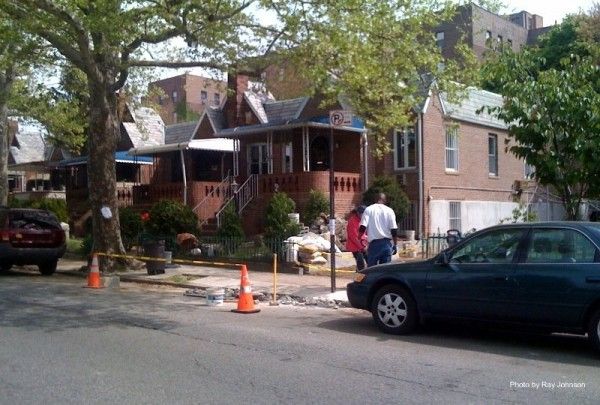Another Free Public Parking Spot Bites The Dust

Construction workers are breaking apart a portion of the curb in front of 2447 East 19 Street, between Avenue Y & Avenue X. Just a day ago, the spot was a sidewalk parking spot in front of a private yard and lawn with pretty landscaping.
The foreman in charge of the work told us that the spot was slated to become a parking entrance for the homeowner’s new driveway. This house is part of a row of attached houses with a shared driveway and parking behind the houses. He continued to tell us that the area behind the house is “too crowded” and that there “is not enough space” for the homeowner to park.
The entire row of houses shares one paved easement at the back, but this end unit is fenced off from the rest of the buildings. Whether this back area of these attached units is supposed to be accessible by the shared easement — as in the case of emergency access for the fire department — is unknown.
When asked if there is a permit to build a new curb cut, the foreman said, “Yes, there is a permit.” We asked him where the parking sign will be placed after the driveway is ready, he told us that “it will stay right there.” After showing him the location of the alternate side of the street sign, he realized that it will be need to be removed and placed in a different spot.
Homeowners on the street told us about competing for parking with visitors and employees of the school across the street. Now, many are worried that one less public street parking spot will add to the frustration, especially on alternate side of the street parking days.
A brochure put out by the NYC Department of Buildings says that “both the Zoning Resolution and the City’s Administrative Code have rules governing the location and design of curb cuts” and there have been numerous recorded disputes about new curb cuts and their legality. The brochure answers questions about curb cuts and describes the procedure for having one approved (link added):
What is a curb cut and why do I need a permit?
…curb cuts must not be located in bus stop zones or too near fire hydrants, utility poles or parking signs.
Installing a curb cut without a permit may result in court appearances and the imposition of fines.
Section 3:
A. Once the application is approved and before any work begins, you (or your contractor) must obtain a construction permit (Form PW-2) from the borough office.
B. Before beginning work, you must also obtain a permit from the Department of Transportation. A DOT permit allows you to alter the existing curb and sidewalk and, if necessary allows you to obstruct the sidewalk while the work is in progress.
Increased construction of concrete driveways and curb cuts replacing what used to be green space in Sheepshead Bay was a topic of discussion in this New York Times article. On April 14, 2010, the City Council adopted the Residential Streetscape Preservation Text Amendment. These rules prohibit homeowners from turning their front yards and gardens into concrete. How the new curb cut and the homeowners were able to cut through the bureaucracy — if it they did indeed — is something that should be shared with the rest of us New Yorkers who seem to get nowhere when trying to deal with the city.




